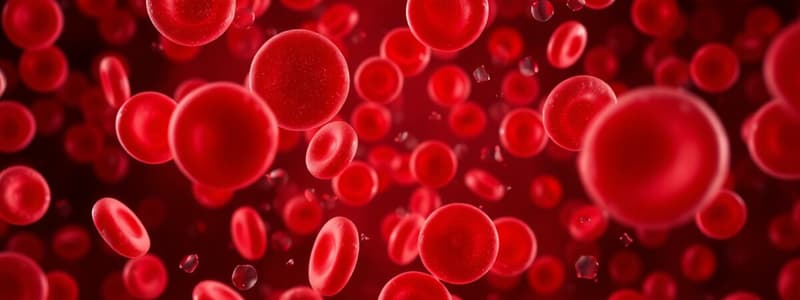Podcast
Questions and Answers
How does plasma differ from serum?
How does plasma differ from serum?
- Serum contains more proteins than plasma.
- Plasma contains more water than serum.
- Serum contains fibrinogen and clotting factors, whereas plasma does not.
- Plasma contains fibrinogen and clotting factors, whereas serum does not. (correct)
If a patient has a condition that impairs the production of erythrocytes, which of the following physiological processes would be most directly affected?
If a patient has a condition that impairs the production of erythrocytes, which of the following physiological processes would be most directly affected?
- Blood clotting
- Waste removal
- Oxygen transport (correct)
- Immune response
During haematopoiesis, what processes are involved in the development of new blood cells?
During haematopoiesis, what processes are involved in the development of new blood cells?
- Only cellular proliferation and differentiation.
- Cellular proliferation, differentiation, morphological changes, functional maturation, and cell death. (correct)
- Only cell morphological changes and functional maturation.
- Only cell death and removal of waste products.
If a patient shows symptoms of impaired blood clotting, which type of blood cell is most likely to be deficient or dysfunctional?
If a patient shows symptoms of impaired blood clotting, which type of blood cell is most likely to be deficient or dysfunctional?
How do leukocytes contribute to maintaining overall body homeostasis?
How do leukocytes contribute to maintaining overall body homeostasis?
Flashcards
Function of Blood
Function of Blood
Blood provides oxygen and nutrients to tissues and removes waste like CO2.
Components of Blood
Components of Blood
Blood consists of plasma, red blood cells, white blood cells, and platelets.
Plasma vs. Serum
Plasma vs. Serum
Plasma contains fibrinogen and clotting factors, while serum does not.
Hematopoietic Stem Cell
Hematopoietic Stem Cell
Signup and view all the flashcards
Functions of Blood Cells
Functions of Blood Cells
Signup and view all the flashcards
Study Notes
Blood Composition and Function
- Blood is crucial for transporting oxygen and nutrients to body tissues, and removing metabolic waste like carbon dioxide.
- Blood's composition includes plasma (water, proteins, and dissolved compounds) and blood cells.
- Plasma differs from serum as it contains clotting factors (fibrinogen).
Haematopoietic System Overview
- The haematopoietic system encompasses all blood cells and their precursors.
- Blood cells include erythrocytes (red blood cells), leukocytes (white blood cells), and thrombocytes (platelets).
- These cells originate from a common progenitor: the hematopoietic stem cell.
- They have distinct developmental stages and locations (blood circulation or specialized development sites).
- Each cell type plays a unique role maintaining bodily equilibrium (homeostasis).
Erythrocytes (Red Blood Cells)
- Erythrocytes transport oxygen and nutrients.
Leukocytes (White Blood Cells)
- Leukocytes are involved in immune defenses.
Thrombocytes (Platelets)
- Platelets play vital roles in blood clotting (hemostasis) and thrombosis.
Haematopoiesis (Blood Cell Production)
- Blood cell production (hematopoiesis) involves several key processes:
- Cell proliferation
- Differentiation from stem cells to mature forms
- Morphological change specific to each cell type
- Functional maturation
- Cell death.
Studying That Suits You
Use AI to generate personalized quizzes and flashcards to suit your learning preferences.




